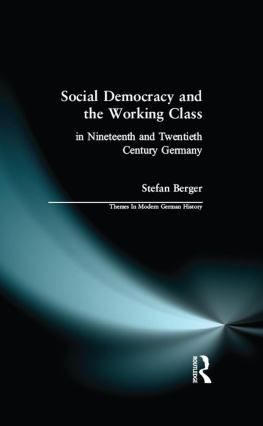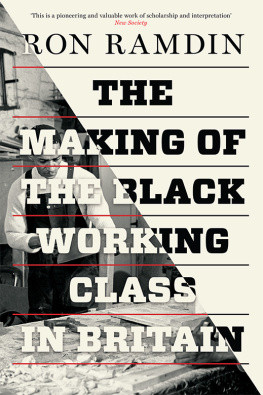ROUTLEDGE LIBRARY EDITIONS:
GERMAN HISTORY
Volume 36
DRINK, TEMPERANCE AND THE WORKING CLASS IN NINETEENTH CENTURY GERMANY
DRINK, TEMPERANCE AND THE WORKING CLASS IN NINETEENTH CENTURY GERMANY
JAMES S. ROBERTS
First published in 1984 by Allen & Unwin Inc.
This edition first published in 2020
by Routledge
52 Vanderbilt Avenue, New York, NY 10017
and by Routledge
2 Park Square, Milton Park, Abingdon, Oxon OX14 4RN
Routledge is an imprint of the Taylor & Francis Group, an informa business
1984 James S. Roberts
All rights reserved. No part of this book may be reprinted or reproduced or utilised in any form or by any electronic, mechanical, or other means, now known or hereafter invented, including photocopying and recording, or in any information storage or retrieval system, without permission in writing from the publishers.
Trademark notice: Product or corporate names may be trademarks or registered trademarks, and are used only for identification and explanation without intent to infringe.
British Library Cataloguing in Publication Data
A catalogue record for this book is available from the British Library
ISBN: 978-0-367-02813-8 (Set)
ISBN: 978-0-429-27806-8 (Set) (ebk)
ISBN: 978-0-367-24832-1 (Volume 36) (hbk)
ISBN: 978-0-429-28460-1 (Volume 36) (ebk)
Publishers Note
The publisher has gone to great lengths to ensure the quality of this reprint but points out that some imperfections in the original copies may be apparent.
Disclaimer
The publisher has made every effort to trace copyright holders and would welcome correspondence from those they have been unable to trace.
Drink, Temperance and the Working Class in Nineteenth-Century Germany
JAMES S. ROBERTS
1984 James S. Roberts
This book is copyright under the Berne Convention. No reproduction
without permission. All rights reserved.
Allen & Unwin, Inc.,
9 Winchester Terrace, Winchester, Mass. 01890, USA
George Allen & Unwin (Publishers) Ltd,
40 Museum Street, London WC1A 1LU, UK
George Allen & Unwin (Publishers) Ltd,
Park Lane, Hemel Hempstead, Herts HP2 4TE, UK
George Allen & Unwin Australia Pty Ltd,
8 Napier Street, North Sydney, NSW 2060, Australia
First published in 1984
Library of Congress Cataloging in Publication Data
Roberts, James S.
Drink, temperance, and the working class in
nineteenth-century Germant.
Bibliography: p.
Includes index.
1. Liquor problemGermanyHistory19th century.
2. TemperanceHistory19th century.
3. Labour and laboring classesGermanySocial conditions. I. Title.
HV5476.R6 1983 394.130943 83-15449
ISBN 0-04-943029-7
British Library Cataloguing in Publication Data
Roberts, James S.
Drink, temperance and the working class in
nineteenth-century Germany.
1. Liqor problemGermanyHistory
I. Title
178.10943 HV5447
ISBN 0-04-943029-7
Set in 10 on 11 point Plantin by Grove Graphics, Tring, Hertfordshire
and printed in Great Britain
by Biddles Ltd., Guildford, Surrey
For
Deborah
In Germany, as in the other industrializing countries of Europe and North America, the Drink Question the discussion of the causes, consequences, and control of popular drinking behaviour was a matter of persistent public concern throughout the nineteenth century. In this book, I attempt to explain why by examining both the realities of popular drinking behavior and the perceptions and activities of those influential Germans who made the Drink Question an enduring public issue. My discussion has three fundamental goals and in pursuing them develops three interrelated arguments. In the first place, I attempt to define the nineteenth-century alcohol problem. I argue that alcohol was not so much psychologically as physiologically rooted in the everyday experience of working-class life. The primary characteristic of popular drinking behavior was not widespread drunkenness but the use, day in and day out, of relatively small quantities of alcohol in a variety of everyday settings. To the extent that drinking was a problem, not for the guardians of social order but for the people consuming the alcohol, the problem was the result of this everyday drinking, deeply rooted in larger patterns of work, diet and sociability. Secondly, I chart the main contours of public concern with the Drink Question in the context of Germanys social, economic, and political development. The Drink Question was taken up both by the educated middle classes and the socialist labor movement. I argue that the temperance reform was more than a reaction to modernity or an effort to manipulate the lower classes, as some commentators have suggested. Instead I try to show how the temperance movement was part of Germanys liberal tradition, sharing both its strengths and its weaknesses. Finally, by drawing on the growing literature on the Drink Question in other nineteenth-century societies, I seek to put Germanys answer to the Drink Question into comparative historical perspective. I argue that social, economic, and political circumstances peculiar to Germany both shaped the terms in which the Drink Question was framed and limited the range of tactical options open to the temperance movement. Unlike its British and American counterparts, the German temperance movement eschewed electoral politics and a direct confrontation with the drink trade. A national consensus about drinking behavior was thus preserved that spared German society the divisive conflicts over alcohol that characterized England and the United States. In proportion to its length, the chronological and geographical sweep of this book is large. What it lacks in local detail, however, I hope it makes up in historical perspective. Although the periodization employed here may seem at first sight to derive only from the landmarks of conventional political history, it is only tangentially related to them. The year 1815 marked the final reckoning with Napoleon and the political restoration effected by the Congress of Vienna, but in terminating years of warfare, it also brought new market conditions to German agriculture that hastened the spread of rural distilleries and thus established the material foundation of the nineteenth-century alcohol problem. And in 1914, when Germany went to war with most of the rest of Europe ranged against her, legal restrictions on the production and consumption of beverage alcohol were put into effect that set the seal on more than a decade of declining per capita consumption. As in so many other ways, the First World War marked the end of an era in Germanys confrontation with the Drink Question as well. The per capita consumption of alcoholic beverages in Germany did not again reach prewar levels until the mid-1960s.
The geographical assumptions of political history may be even less appropriate for social history than the temporal ones. Nonetheless, the locus of study in this book is the Germany defined by the kleindeutsche nation state of 1871. After mid-century the German temperance movement became increasingly national in scope and increasingly political in tactics. In attempting to shape the many aspects of the Imperial Commercial Code that affected the drink trade, for example, the temperance movement had perforce to operate on the national level. The movement was therefore shaped by national institutions, and it was these that it most wanted to influence. This national focus may obscure the subtleties of regional variation and local custom, especially in the discussion of drinking behaviour itself. I have done my best to acknowledge these nuances, but I have not been able to explore them in any detail.







